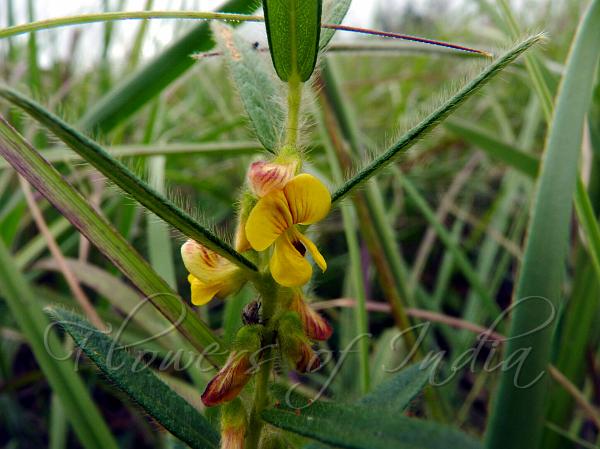|
| Chinese Sand Pea |
|

|

| File size | 586453 |
| Original date | 6/29/25 3:07 PM |
| Resolution | 2048 x 1536 |
| Flash | Flash did not fire, auto |
| Focal length | 4.8mm |
| Exposure time | 1/200s |
| Aperture | 4.0 |
| Focus Distance | |
| Metering Mode | Multi-segment |
| Camera make | Panasonic |
| Camera model | DMC-FZ35 |
| Sensor type | OneChipColorArea |
|
|
|
|
Photo: |
Botanical name: Eriosema chinense Family: Fabaceae (Pea family)
Synonyms: Crotalaria hamiltonii, Eriosema himalaicum, Eriosema tuberosum
Synonyms: Crotalaria hamiltonii, Eriosema himalaicum, Eriosema tuberosum
Chinese Sand Pea is a perennial, erect herb, 12-50 cm
tall. Flowers are borne in racemes in leaf-axils, extremely short, 1-
or 2-flowered; bracts linear. Flowers are pale yellow; standard
obovate, base with 2 drooping oblong ears; wings obovate-oblong, eared
on one side; keel shorter than wings, obovate-oblong. Sepal-cup is
bell-shaped, 3-5 mm, 5-lobed, brown hairy. Ovary is densely long
hirsute; style inflexed, hairless. Root tuber is spindle-shaped to
spherical, fleshy. Stems are densely hairy. Leaves are 1-foliolate;
blade lanceshaped, 1.5-7 x 0.4-1.5 cm, underside shortly hairy, upper
surface and margins sparsely hairy, base rounded or nearly
heart-shaped, tip blunt or pointed. Pod is rhomboid-elliptic or
oblong, 8-10 x 5-6 mm, black when mature, hairy. Chinese Sand Pea is
found in mountains at altitudes of 300-2000 m, in Tropical &
Subtropical Asia to N. Australia. Flowering: May-July.
Medicinal uses: The seeds are astringent,
diuretic and tonic. A decoction is given to women to promote discharge
of the afterbirth, and to treat leucorrhoea and menstrual derangements.
A decoction, combined with ground pepper (Piper species), is used in
the treatment of scrofula and diarrhoea. The seed powder is externally
applied to check cold sweats.
The seeds are astringent,
diuretic and tonic. A decoction is given to women to promote discharge
of the afterbirth, and to treat leucorrhoea and menstrual derangements.
A decoction, combined with ground pepper (Piper species), is used in
the treatment of scrofula and diarrhoea. The seed powder is externally
applied to check cold sweats.
Medicinal uses:
 The seeds are astringent,
diuretic and tonic. A decoction is given to women to promote discharge
of the afterbirth, and to treat leucorrhoea and menstrual derangements.
A decoction, combined with ground pepper (Piper species), is used in
the treatment of scrofula and diarrhoea. The seed powder is externally
applied to check cold sweats.
The seeds are astringent,
diuretic and tonic. A decoction is given to women to promote discharge
of the afterbirth, and to treat leucorrhoea and menstrual derangements.
A decoction, combined with ground pepper (Piper species), is used in
the treatment of scrofula and diarrhoea. The seed powder is externally
applied to check cold sweats. | Identification credit: Tabish | Photographed in Meghalaya. |
• Is this flower misidentified? If yes,